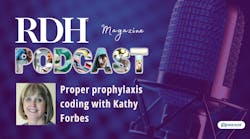Are D1110/D1120 the proper CDT procedure codes for oral preventive assistants/scaling assistants?
What you'll learn in this article
- How to code supragingival scaling performed by dental assistants.
- Why D1999 is appropriate for coronal scaling documentation.
- The evolution of CDT code descriptors for prophylaxis procedures.
- Risks of misusing D1110 or D1120 in documentation.
- Ethical coding practices per ADA guidelines and definitions.
Question: Dental assistants in several states can now perform a prophylaxis. How do offices code this for documentation and insurance purposes? What is the CDT procedure code if an assistant is allowed to scale supragingivally?
Answer: The quick answer is that if a hygienist or dentist does not need to complete any subgingival scaling on the patient, the most appropriate would be D1999 with a narrative of “coronal scaling on an adult” or “coronal scaling on a child.”
Often the next question is: Why not select D1120 (child prophylaxis on primary or transitional dentition) or D1110 (adult prophylaxis on permanent or transitional dentition)?
The response to this is that both procedure codes’ descriptors begin with “removal of plaque, calculus, and stains from the tooth structures and implants,” not just the supragingival/coronal part of the tooth. But it hasn’t always been this way.
It’s important to understand how the ADA defines “coronal” and “clinical crown.” From the Glossary of Dental Clinical Terms: Coronal refers to the crown of a tooth, and clinical crown is that portion of a tooth not covered by tissues.
The Code Maintenance Committee, under authority of the Council on Dental Benefit Programs, is very deliberate and specific when it comes to developing procedure code descriptors. They try to be as precise as possible when it comes to creating procedure codes, and even more specific when it comes to amending current procedure codes.
The first time descriptors were included in the manual was in CDT-2 1995-2000, and the decision was made to identify that the prophylaxis procedure involves only removing plaque, calculus, and stains supragingivally on the clinical crown.
D1110 prophylaxis–adult: A dental prophylaxis performed on transitional or permanent dentition that includes scaling and polishing procedures to remove coronal plaque, calculus, and stains. Some patients may require more than one appointment or one extended appointment to complete a prophylaxis. A document is needed for additional time or appointments.
D1120 prophylaxis–child: A routine dental prophylaxis performed on primary or transitional dentition only.
For the next five years (2000-2005), there were subtle amendments to these codes, but the descriptors continued to state, “Remove coronal plaque, calculus, and stains.” Thus, if either of these procedures were documented and billed as such, the clinician was stating they only removed deposits on that part of the tooth that was not covered by tissues, i.e., supragingival deposits above the gumline. But those of us in practice all know we did remove deposits subgingivally to the base of the sulcus as well.
When CDT 2005-2006 was published, the descriptors were significantly changed to remove the word “coronal” since it became clear that hygienists were removing deposits subgingivally as well as supragingivally. The descriptors were amended to “tooth structures” to identify that the deposits were being removed down to the base of the sulcus, which hygienists had been doing for years!
D1110 prophylaxis–adult: Removal of plaque, calculus, and stains from the tooth structures in the permanent and transitional dentition. It is intended to control local irritational factors.
D1120 prophylaxis–child: Removal of plaque, calculus and stains from the tooth structures in the primary and transitional dentition. It is intended to control local irritational factors.
For the past 20 years, no significant amendments have been made to the prophylaxis procedure codes other than adding “and implants” in CDT 2021. The current descriptors from CDT 2025, page 13 state:
D1110 prophylaxis–adult: Removal of plaque, calculus, and stains from the tooth structures and implants in the permanent and transitional dentition. It is intended to control local irritational factors.
D1120 prophylaxis–child: Removal of plaque, calculus, and stains from the tooth structures and implants in the primary and transitional dentition. It is intended to control local irritational factors.
In conclusion, since the legislation that has been passed in several states and proposed in other states limits oral preventive assistants/scaling assistants to remove deposits supragingivally (above the gumline), there is no code for this specific procedure. If there is no procedure code that accurately describes the service provided, a “D_999” code, or in this instance, D1999, would be appropriate with a narrative of “coronal scaling–adult” or “supragingival scaling–adult.”
Submitting as D1110 or D1120 by an oral preventive assistant/scaling assistant—if no subgingival scaling was necessary by a dentist or hygienist—could be considered a false or misleading representation to an insurance carrier and the submission could be considered a fraudulent act.
As stated in the ADA Code of Ethics, Section 5, Principle Veracity (truthfulness): 5.B.5: Dental procedures: “A dentist who incorrectly describes on a third-party claim form a dental procedure in order to receive a greater payment or reimbursement or incorrectly makes a noncovered procedure appear to be a covered procedure on such a claim form is engaged in making an unethical, false, or misleading representation to such third party.”
About the Author

Kathy S. Forbes, BS, RDH, FADHA
Kathy S. Forbes, BS, RDH, FADHA, brings over four decades of passion and expertise to the dental profession as a clinician, educator, speaker, author, and consultant. Known for turning complex coding topics into clear, practical insights, Kathy helps dental teams connect accurate documentation and coding with quality patient care. Kathy serves as a Director for the DentalCodeology Consortium, where she works with hygienists from across the country to review and develop dental hygiene–related procedure codes and presents testimony annually to the ADA’s Code Maintenance Committee.
Reach her at [email protected].


